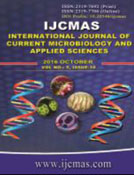


 National Academy of Agricultural Sciences (NAAS)
National Academy of Agricultural Sciences (NAAS)

|
PRINT ISSN : 2319-7692
Online ISSN : 2319-7706 Issues : 12 per year Publisher : Excellent Publishers Email : editorijcmas@gmail.com / submit@ijcmas.com Editor-in-chief: Dr.M.Prakash Index Copernicus ICV 2018: 95.39 NAAS RATING 2020: 5.38 |
Plasmid curing of bacteria isolated from leachate samples in Ebira communities of Ekiti Central and South in Ekiti State senatorial district were analyzed. Microbial count, antibiotics sensitivity and plasmid profile were assayed using pour plate, disk diffusion and gel electrophoresis techniques respectively; while the plasmids were cured using acridine orange. The total bacterial, total coliform and total enteric bacteria counts of the leachate samples ranged from 0.64 × 108 to 0.85 × 109CFU/ml, 0.78 × 108 to 0.76 × 109CFU/ml and 1.90 × 108 to 2.30 × 109CFU/ml respectively. The percentage distributions revealed that Escherichia coli with 29.2% had the highest frequency of occurrence while Enterobacter aerogenes had the lowest occurrence of 7.5%. The antibiotics sensitivity test showed that the least percentage (3%) of the isolates were resistant to ofloxacin while the highest percentage (99%) of the isolates were resistant to cefuroxime. Multiple Antibiotics Resistant bacteria were subjected to plasmid analysis showing that nine (9) were devoid of plasmid while other six (6) isolates carry plasmid with high molecular weight, ranging from 9.41kbp to 23.130kpb. Three of the MAR isolates (Escherichia coli, Pseudomonas aeruginosa and Enterococcus feacalis) were selected for curing. The three (3) retained resistance pattern to all antibiotics used aside Escherichia coli and Pseudomonas aeruginosa that became susceptible to ofloxacin after curing. Incidence of such MAR bacterial isolates in leachate samples is however an indication of possible environmental hazard.
 |
 |
 |
 |
 |